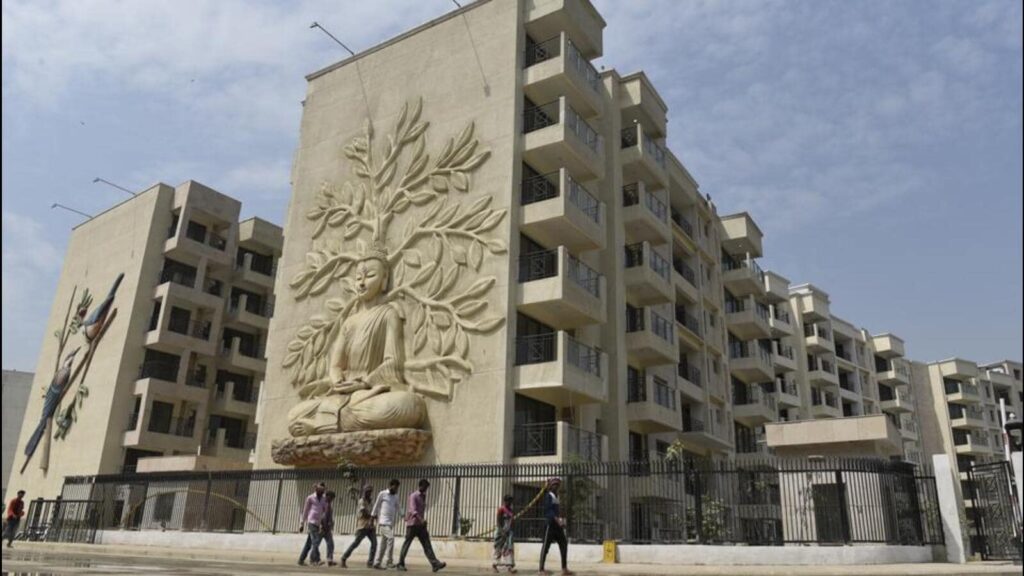GPRA colonies ready but no elevated road in sight | Latest News Delhi

In July 2021, a 14km-long corridor from Barapullah near Thyagraj Stadium to Mahipalpur bypass was approved cutting across south Delhi. More than three years on, this grand elevated road project, which targets the decongestion of the areas around the seven Government Pool Residential Accommodation (GPRA) colonies, remains only on paper.

While several infrastructure projects, including the GPRA colonies, are either finished, nearing competition or are in various stages of development, the construction of the elevated road is nowhere near the starting stage.
The corridor was supposed to handle the increased load of traffic after the completion of high-rise structures as part of the redevelopment of the GPRA colonies — Nauroji Nagar, Netaji Nagar, Sarojini Nagar, Mohammaddpur, Thyagraj Nagar, Kasturba Nagar and Srinivaspuri.
Apart from these, the initial approvals for the phased expansion of the AIIMS campus were given in September 2022 contingent on this corridor. However, while the Naoroji Nagar World Trade Centre is ready, and the redevelopment in Sarojini Nagar is expected to be finished within a month, the Union ministry of housing and urban affairs (MoHUA) has not yet approved the final design for the elevated corridor even as the vehicular movement is expected to multiply in these areas in the coming few months, officials aware of the matter said. Redevelopment at Naoroji Nagar was completed by May this year and possession of commercial spaces has begun in a phased manner.
The Central Public Works Department (CPWD) is the agency responsible for carrying out the construction of the corridor.
While it did not respond to official queries over its progress, an agency official, on condition of anonymity said, “It was initially planned that the NBCC (India) Limited would take care of the funding of this corridor from the sale of commercial units being built at the redeveloped GPRA colonies, but such funds have not been generated yet. Additionally, the original layout alignment has gone through multiple rounds of changes to allow for it to integrate with the existing road infrastructure. However, the design has not been finalised yet and is being reviewed by the ministry.”
Meanwhile, other CPWD officials, on condition of anonymity, said that the project may also be scrapped.
The construction of the 14km elevated corridor, aimed at providing better access to the airport, was approved by the Unified Traffic and Transportation Infrastructure (Planning and Engineering) Centre (UTTIPEC) at an approximate cost of ₹5,000 crore.
According to the approved alignment available on the UTTIPEC website, the six-lane corridor was supposed to start from Barapullah flyover near Thyagraj stadium and pass through Aurobindo Marg, Brigadier Hoshiyar Singh Road, Africa Avenue, Vivekanand Marg, Nelson Mandela Road, Vasant Kunj Road and Mahipalpur Bypass, and touch down at National Highway-8 with ramps for entry and exit near all residential colonies.
With no progress on ground, the traffic along the Ring Road is already reaching a tipping point, leading to hours of congestion during the morning and evening peak hours. According to recent estimates by the Delhi Public Works Department, about 130,000 vehicles pass through the AIIMS crossing every day, and another 330,000 vehicles ply between Bhikaji Cama Place and Lajpat Nagar flyovers on a daily basis. While commuters face inconvenience every day, authorities have not moved on the proposal, unclear on how the congestion, which is only likely to increase in these areas, will be dealt with.
When contacted, neither the MoHUA nor NBCC responded to HT’s queries on the progress of the proposed elevated corridor.
The GPRA colonies were introduced in Delhi in the pre-Independence era for providing quarters to civil servants and other government staff. As the administrative structure grew, so did the demand for more housing units, leading to the creation of over 50 such colonies across Delhi — most of them in areas around south and central Delhi.
With a further increase in demand, in 2016, the MoHUA decided to redevelop the seven aforesaid GPRA colonies to increase the housing stock from 12,970 to 25,667 units, while the one in Kidwai Nagar was approved by UTTIPEC in 2013,redeveloped in 2014, and the first lot of flats were completed and handed over in 2018. This was expected to address the housing shortage along with improving the condition of the over 50-year-old dilapidated structures.
Experts say that the redevelopment plan of GPRA colonies as well as the elevated corridor are both examples of bad planning. Even in the case of East Kidwai Nagar earlier, the issue was raised in court and an IIT Delhi report had mentioned that the traffic plan was inadequate and the increased traffic load caused by the project would result in congestion on Ring Road and Aurobindo Road, they said.
“The obvious question here is: what will happen to the traffic at-grade? The Ring Road already has multiple flyovers. So this elevated GPRA corridor will be a third layer of road in the area, which will only make the traffic chaotic. There will be a need for multiple ramps for entry and exit from these colonies and with vehicles leaving the elevated corridor to enter these colonies, the at-grade traffic will become a mess. Even engineering-wise, it is not an easy task to plan and execute a third layer of road network, which may be one of the reasons that it has not been able to get all approvals so far. The engineering feasibility can only come with a huge cost escalation,” said S Velmurugan, chief scientist and head of traffic engineering and safety division of Central Road Research Institute (CRRI).
He added that the traffic plan should have been completely ready before such large-scale redevelopment was started with high-rises and commercial development that will increase the floor area ration by at least 15 times. He said that such development will also increase pressure on civic amenities such as water supply, drainage and parking requirement.
“A possible solution is that the existing flyovers should be integrated along the Ring Road and more holistic transportation planning should be done,” said Velmurugan.




